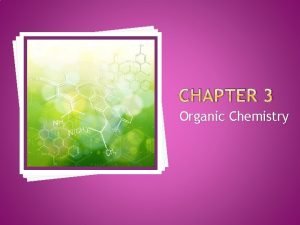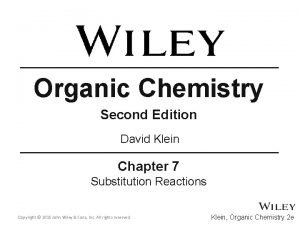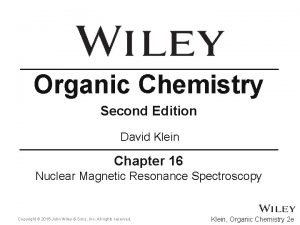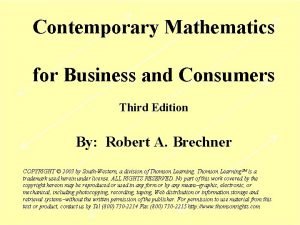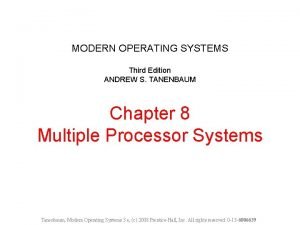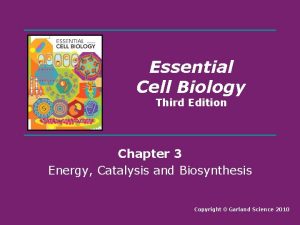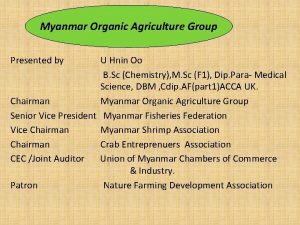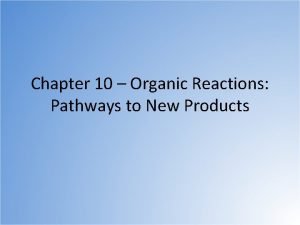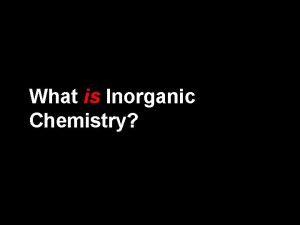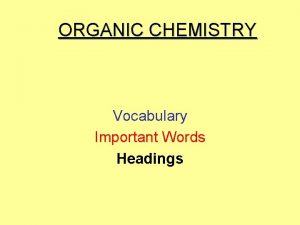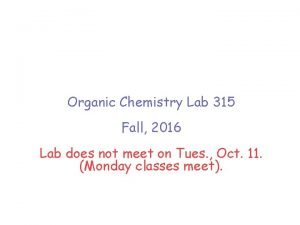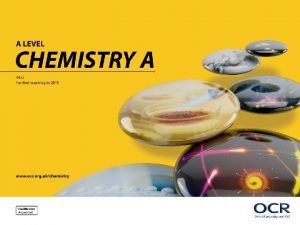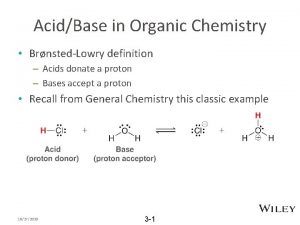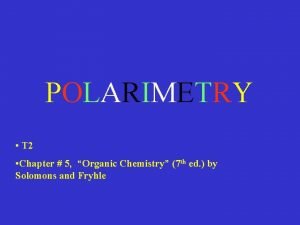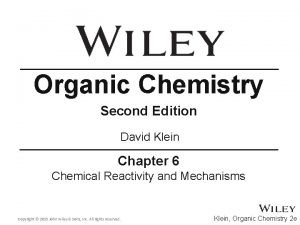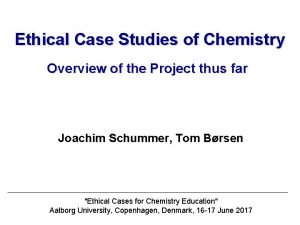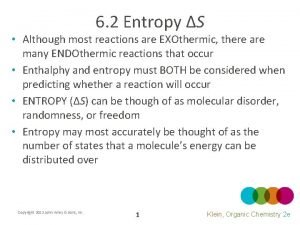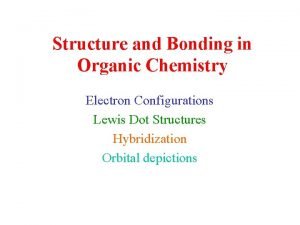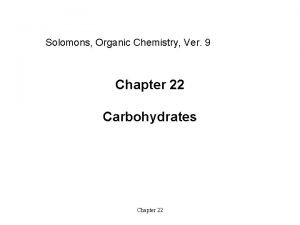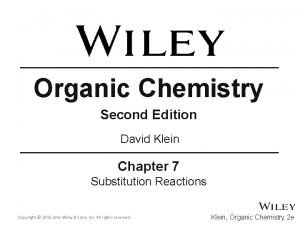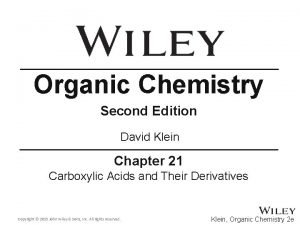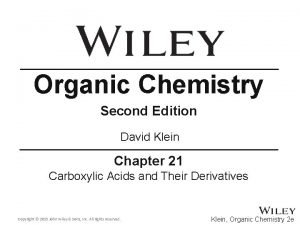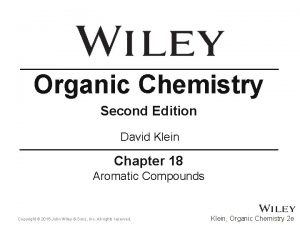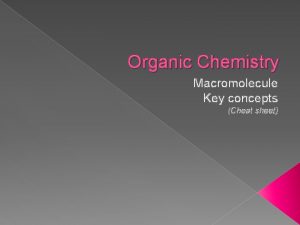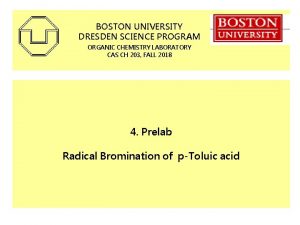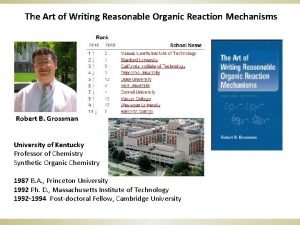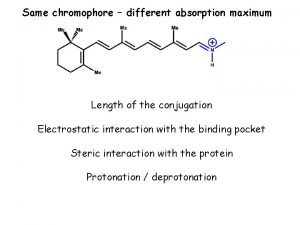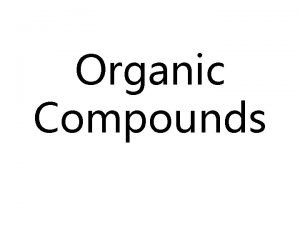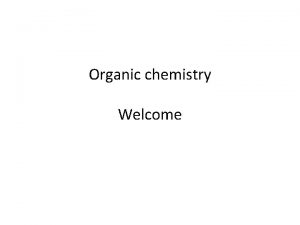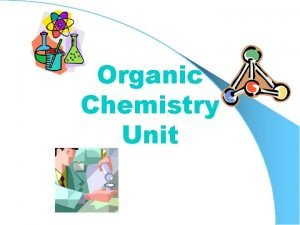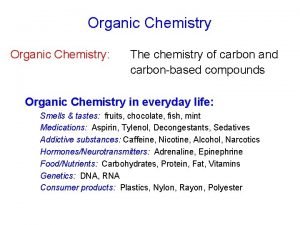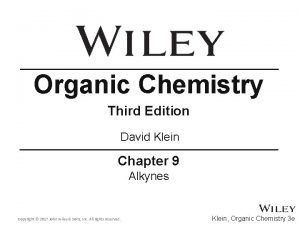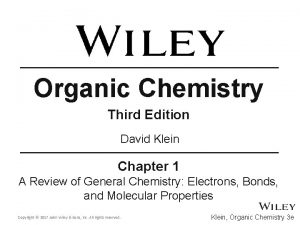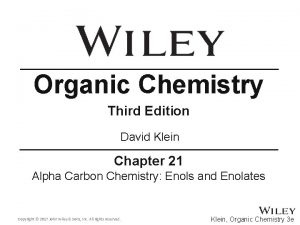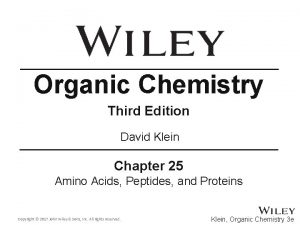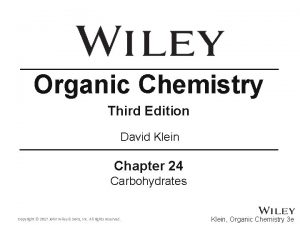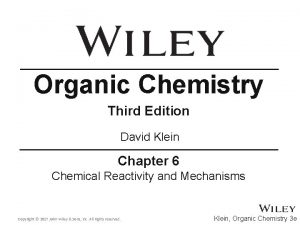Organic Chemistry Third Edition David Klein Chapter 10


















































































- Slides: 82

Organic Chemistry Third Edition David Klein Chapter 10 Radical Reactions Copyright © 2017 John Wiley & Sons, Inc. All rights reserved. Klein, Organic Chemistry 3 e

10. 1 Radicals - Introduction • Free radicals form when bonds break homolytically • Note the single-barbed or fishhook arrow used to show the electron movement Copyright © 2017 John Wiley & Sons, Inc. All rights reserved. 10 -2 Klein, Organic Chemistry 3 e

10. 1 Radical Structure and Geometry • Recall the orbital hybridization in carbocations and carbanions Copyright © 2017 John Wiley & Sons, Inc. All rights reserved. 10 -3 Klein, Organic Chemistry 3 e

10. 1 Radical Structure and Geometry • Radicals appear to be trigonal planar (sp 2 hybridized) or shallow trigonal planar (sp 3 hybridized) sp 2 hybridized Copyright © 2017 John Wiley & Sons, Inc. All rights reserved. 10 -4 Klein, Organic Chemistry 3 e

10. 1 Free Radical Stability • Radicals are neutral (no formal charge) but still electron deficient (incomplete octet) • Radicals follow the same stability trend as carbocations, as they are both electron deficient species Copyright © 2017 John Wiley & Sons, Inc. All rights reserved. 10 -5 Klein, Organic Chemistry 3 e

10. 1 Free Radical Stability • Bond strength is inversely proportional to carbon radical stability. • The more stable the resulting radical(s), the weaker the bond • Practice with Conceptual Checkpoint 10. 1 Copyright © 2017 John Wiley & Sons, Inc. All rights reserved. 10 -6 Klein, Organic Chemistry 3 e

10. 1 Free Radical Resonance • Radicals, like carbocations, are stabilized by resonance delocalization. • Fishhook arrows are used to present possible resonance forms Copyright © 2017 John Wiley & Sons, Inc. All rights reserved. 10 -7 Klein, Organic Chemistry 3 e

10. 1 Free Radical Resonance • The more resonance delocalized a radical is, the more stable it is • Benzylic radicals are more stable than allylic radicals because the radical is delocalized over more carbon atoms Copyright © 2017 John Wiley & Sons, Inc. All rights reserved. 10 -8 Klein, Organic Chemistry 3 e

10. 1 Resonance Stabilization • Resonance stabilized radicals are more stable than 3˚ radicals • Practice with Skill. Builder 10. 1 Copyright © 2017 John Wiley & Sons, Inc. All rights reserved. 10 -9 Klein, Organic Chemistry 3 e

10. 1 Radical Stability • Vinylic radicals are especially unstable (as with vinyl cations) • A radical in a sp 2 orbital is less stable than one in a sp 3 orbital • Practice with Skill. Builder 10. 2 Copyright © 2017 John Wiley & Sons, Inc. All rights reserved. 10 -10 Klein, Organic Chemistry 3 e

10. 2 Patterns in Radical Mechanisms • Like ionic mechanisms, radical mechanisms follow patterns • But, radical mechanisms are distinctively different. • For example, radicals do not undergo rearrangement • Radical mechanisms follow SIX key arrow-pushing patterns Copyright © 2017 John Wiley & Sons, Inc. All rights reserved. 10 -11 Klein, Organic Chemistry 3 e

10. 2 Patterns in Radical Mechanisms 1. Homolytic Cleavage: initiated by light or heat 2. Addition to a pi bond 3. Hydrogen abstraction: not the same as proton transfer 4. Halogen abstraction Copyright © 2017 John Wiley & Sons, Inc. All rights reserved. 10 -12 Klein, Organic Chemistry 3 e

10. 2 Patterns in Radical Mechanisms 5. Elimination: The reverse of addition • the radical, on the α carbon is pushed toward the β carbon to eliminate a radical atom/group 6. Coupling: the reverse of homolytic cleavage Copyright © 2017 John Wiley & Sons, Inc. All rights reserved. 10 -13 Klein, Organic Chemistry 3 e

10. 2 Patterns in Radical Mechanisms • Group the relationship(s) among these six patterns and you see there are only 3 processes, forward and backward • Practice with Skill. Builder 10. 3 Copyright © 2017 John Wiley & Sons, Inc. All rights reserved. 10 -14 Klein, Organic Chemistry 3 e

10. 2 Patterns in Radical Mechanisms • The steps in a radical mechanism are classified as either initiation, termination, or propagation • An initiation step is one where radical species are formed from a non-radical species Copyright © 2017 John Wiley & Sons, Inc. All rights reserved. 10 -15 Klein, Organic Chemistry 3 e

10. 2 Patterns in Radical Mechanisms • Propagation occurs when radical reacts with a non-radical species, to form a new radical (and non-radical) Copyright © 2017 John Wiley & Sons, Inc. All rights reserved. 10 -16 Klein, Organic Chemistry 3 e

10. 2 Patterns in Radical Mechanisms • Termination occurs when two radical species react to form a nonradical species • The complete definitions of initiation, propagation and termination will be discussed later Copyright © 2017 John Wiley & Sons, Inc. All rights reserved. 10 -17 Klein, Organic Chemistry 3 e

10. 3 Chlorination of Methane • Chlorination of methane follows a radical mechanism: • Radical mechanism consists of three distinct stages: 1. INITIATION: chlorine radicals are created Copyright © 2017 John Wiley & Sons, Inc. All rights reserved. 10 -18 Klein, Organic Chemistry 3 e

10. 3 Chlorination of Methane 2. PROPAGATION: these steps are self-sustaining. The first propagation step consumes a Cl radical, and the second step produces one. Copyright © 2017 John Wiley & Sons, Inc. All rights reserved. 10 -19 Klein, Organic Chemistry 3 e

10. 3 Chlorination of Methane 3. TERMINATION: occurs when radicals collide/couple. Copyright © 2017 John Wiley & Sons, Inc. All rights reserved. 10 -20 Klein, Organic Chemistry 3 e

10. 3 Chlorination of Methane • The sum of the propagation steps gives the net reaction: • Propagation is a chain reaction: the product(s) for a later step serve as reactant(s) for an earlier step in the mechanism Copyright © 2017 John Wiley & Sons, Inc. All rights reserved. 10 -21 Klein, Organic Chemistry 3 e

10. 3 Chlorination of Methane • Polychlorination is difficult to prevent • Methyl chloride is more reactive towards radical halogenation than methane • Need excess methane, relative to Cl 2, for monochlorination to be the major product. • Practice with Skill. Builder 10. 4 Copyright © 2017 John Wiley & Sons, Inc. All rights reserved. 10 -22 Klein, Organic Chemistry 3 e

10. 3 Radical Initiators • Radical initiator: possesses a weak bond that cleaves homolytically with heat or light dihalides alkyl peroxides acyl peroxides • The acyl peroxide is most reactive, and is effective at 80 °C Copyright © 2017 John Wiley & Sons, Inc. All rights reserved. 10 -23 Klein, Organic Chemistry 3 e

10. 3 Radical Inhibitors • Radical inhibitors: react with radicals, and prevent a chain process from initiating or propagating • Stabilized radicals and compounds that easily form stabilized radicals are good inhibitors: Oxygen is a diradical, and will react with two other radicals Hydroquinone will also react with two radicals • Radical reactions are very slow in the presence of oxygen Copyright © 2017 John Wiley & Sons, Inc. All rights reserved. 10 -24 Klein, Organic Chemistry 3 e

10. 3 Radical Inhibitors • Hydroquinone undergoes H-abstraction to form a resonancestabilized radical Copyright © 2017 John Wiley & Sons, Inc. All rights reserved. 10 -25 Klein, Organic Chemistry 3 e

10. 4 Halogenation Thermodynamics • If we want to determine whether a process is product favored, we must determine the sign (+/-) for ΔG • In a halogenation reaction, entropy is negligible. • # of reactants = # of products Copyright © 2017 John Wiley & Sons, Inc. All rights reserved. 10 -26 Klein, Organic Chemistry 3 e

10. 4 Halogenation Thermodynamics • Can estimate the value of ΔH based on BDE’s for the bonds broken versus the bonds made in the reaction: Copyright © 2017 John Wiley & Sons, Inc. All rights reserved. 10 -27 Klein, Organic Chemistry 3 e

10. 4 Halogenation Thermodynamics Copyright © 2017 John Wiley & Sons, Inc. All rights reserved. 10 -28 Klein, Organic Chemistry 3 e

10. 4 Halogenation Thermodynamics • Fluorination is so exothermic, it is not practical (too violent) • Iodination is endothermic, not thermodynamically favored, and doesn’t occur • Only halogenation with Cl 2 and Br 2 are useful Copyright © 2017 John Wiley & Sons, Inc. All rights reserved. 10 -29 Klein, Organic Chemistry 3 e

10. 4 Halogenation Thermodynamics • Both chlorination and bromination are exothermic (favored). • But, DH for the first step of bromination is endothermic Copyright © 2017 John Wiley & Sons, Inc. All rights reserved. 10 -30 Klein, Organic Chemistry 3 e

10. 4 Halogenation Thermodynamics • So, bromination is much slower than chlorination • These means bromination is more selective. Copyright © 2017 John Wiley & Sons, Inc. All rights reserved. 10 -31 Klein, Organic Chemistry 3 e

10. 5 Halogenation Regioselectivity • With substrates more complex than ethane, multiple monohalogenation products are possible two monohalogenation products are possible for propane • Chlorine is indiscriminant; significant amount of each product is formed Copyright © 2017 John Wiley & Sons, Inc. All rights reserved. 10 -32 Klein, Organic Chemistry 3 e

10. 5 Halogenation Regioselectivity • But since 2˚ radicals are more stable than 1˚, the secondary halide is the major product Hydrogen abstraction from a 2˚ carbon is faster than a 1˚ carbon Copyright © 2017 John Wiley & Sons, Inc. All rights reserved. 10 -33 Klein, Organic Chemistry 3 e

10. 5 Halogenation Regioselectivity • Bromination is much slower, and so it is much more selective for the more reactive 2˚ carbon: • The fact bromination is more regioselective than chlorination can be explained by the Hammond Postulate Copyright © 2017 John Wiley & Sons, Inc. All rights reserved. 10 -34 Klein, Organic Chemistry 3 e

10. 5 Halogenation Regioselectivity • Focus on the H abstraction (rate determining) step. • The transition state will be more like the reactants or more like the products, whichever is closer in energy chlorination TS resembles reactants Copyright © 2017 John Wiley & Sons, Inc. All rights reserved. bromination TS Resembles products 10 -35 Klein, Organic Chemistry 3 e

10. 5 Halogenation Regioselectivity Copyright © 2017 John Wiley & Sons, Inc. All rights reserved. 10 -36 Klein, Organic Chemistry 3 e

10. 5 Halogenation Regioselectivity • For bromination, the stability of the transition state largely depends on the stability of the resulting carbon radical • For chlorination, the stability of the transition state does not depend on the stability of the resulting carbon radical so much. Copyright © 2017 John Wiley & Sons, Inc. All rights reserved. 10 -37 Klein, Organic Chemistry 3 e

10. 5 Halogenation Regioselectivity • In short, the difference in TS energies for the formation of a 1 vs. 2˚ vs 3˚ radicals is much bigger for bromination • Thus, bromination is more selective for the lower energy pathway Copyright © 2017 John Wiley & Sons, Inc. All rights reserved. 10 -38 Klein, Organic Chemistry 3 e

10. 5 Halogenation Regioselectivity • Bromination at the 3° position happens 1600 times more often than at the 1° position Copyright © 2017 John Wiley & Sons, Inc. All rights reserved. 10 -39 Klein, Organic Chemistry 3 e

10. 5 Halogenation Regioselectivity • Flourination is the fastest process, and thus the least selective • Practice with Skill. Builder 10. 5 Copyright © 2017 John Wiley & Sons, Inc. All rights reserved. 10 -40 Klein, Organic Chemistry 3 e

10. 6 Halogenation Stereochemistry • The halogenation of butane or more complex alkanes forms a new chirality center • 2 -chlorobutane will form as a racemic mixture Copyright © 2017 John Wiley & Sons, Inc. All rights reserved. 10 -41 Klein, Organic Chemistry 3 e

10. 6 Halogenation Stereochemistry • Whether the free radical carbon is sp 2 or a rapidly interconverting sp 3, the halogen abstraction will occur on either side of the plane with equal probability sp 2 hybridized Copyright © 2017 John Wiley & Sons, Inc. All rights reserved. 10 -42 Klein, Organic Chemistry 3 e

10. 6 Halogenation Stereochemistry • There is actually a total of three monosubstituted products form in the halogenation of butane Copyright © 2017 John Wiley & Sons, Inc. All rights reserved. 10 -43 Klein, Organic Chemistry 3 e

10. 6 Halogenation Stereochemistry • In the halogenation of (S)-3 -methylhexane, the chirality center is the most reactive carbon in the molecule. A racemic mixture will be obtained • The chirality center is a 3˚ carbon, and it has a weaker C-H bond than the 2˚ and 1˚ carbons • Practice with Skill. Builder 10. 6 Copyright © 2017 John Wiley & Sons, Inc. All rights reserved. 10 -44 Klein, Organic Chemistry 3 e

10. 7 Allylic Halogenation • Recall the weakest C-H bond (lowest BDE) will undergo radical Habstraction faster than the others. • Alkenes selectively undergo H-abstraction at the allylic carbon Copyright © 2017 John Wiley & Sons, Inc. All rights reserved. 10 -45 Klein, Organic Chemistry 3 e

10. 7 Allylic Halogenation • H-abstraction of an allylic H results in a resonance-stabilized allylic radical: • So, bromination of an alkene is selective for the allylic carbon • But, addition of Br 2 to the alkene is a competing reaction… Copyright © 2017 John Wiley & Sons, Inc. All rights reserved. 10 -46 Klein, Organic Chemistry 3 e

10. 7 Allylic Halogenation with NBS • To avoid the competing alkene addition, NBS is used as a source of Br radicals (instead of using Br 2) • Using NBS keeps the concentration of HBr and Br 2 low, so competing addition reactions to the alkene are minimized Copyright © 2017 John Wiley & Sons, Inc. All rights reserved. 10 -47 Klein, Organic Chemistry 3 e

10. 7 Allylic Halogenation with NBS • Propagation produces the allylic radical and HBr • The HBr produced reacts with NBS to form Br 2 … and this Br 2 then continues propagation and the formation of the product Copyright © 2017 John Wiley & Sons, Inc. All rights reserved. 10 -48 Klein, Organic Chemistry 3 e

10. 7 Allylic Halogenation with NBS • With asymmetric alkenes, a mixture of isomeric products is often obtained • The radical is delocalized on two carbon atoms, and so halogenation occurs at either site • Practice with Skill. Builder 10. 7 Copyright © 2017 John Wiley & Sons, Inc. All rights reserved. 10 -49 Klein, Organic Chemistry 3 e

10. 8 Atmospheric Chemistry and O 3 • Ozone is both created and destroyed in the upper atmosphere • No net reaction is had overall, but UV radiation is converted to heat Copyright © 2017 John Wiley & Sons, Inc. All rights reserved. 10 -50 Klein, Organic Chemistry 3 e

10. 8 Atmospheric Chemistry and O 3 • Heat is a more disordered form of energy, compared to light • This process is spontaneous because entropy is increased Copyright © 2017 John Wiley & Sons, Inc. All rights reserved. 10 -51 Klein, Organic Chemistry 3 e

10. 8 Atmospheric Chemistry and O 3 • O 3 depletion is a serious health and environmental problem. Without it, harmful UV radiation penetrations the atmosphere. • Chlorofluorocarbons are believed to be the culprit • They reach the upper atmosphere, and react with UV light to form chlorine radicals Copyright © 2017 John Wiley & Sons, Inc. All rights reserved. 10 -52 Klein, Organic Chemistry 3 e

10. 8 Atmospheric Chemistry and O 3 • The Cl radicals destroy ozone by the following mechanism • Cl radicals are formed during propagation, and continue the destruction of ozone molecules Copyright © 2017 John Wiley & Sons, Inc. All rights reserved. 10 -53 Klein, Organic Chemistry 3 e

10. 8 Atmospheric Chemistry and O 3 • CFC’s have been replaced with hydrofluoroalkanes (HFA’s) • They are sometimes called hydrofluorocarbons (HFC’s) • They are not as harmful as CFC’s because they don’t produce chlorine radicals, but they still act as greenhouse gases Copyright © 2017 John Wiley & Sons, Inc. All rights reserved. 10 -54 Klein, Organic Chemistry 3 e

10. 9 Autooxidation • Autooxidation is the process by which organic compounds react with atmospheric oxygen to form a hydroperoxide • The process is generally very slow Copyright © 2017 John Wiley & Sons, Inc. All rights reserved. 10 -55 Klein, Organic Chemistry 3 e

10. 9 Autooxidation Mechanism The initiation step is actually a propagation based on our earlier definitions… …so the definitions need to be revised Copyright © 2017 John Wiley & Sons, Inc. All rights reserved. 10 -56 Klein, Organic Chemistry 3 e

10. 9 Autooxidation Mechanism • Propagation steps can be more precisely defined as the steps that add together to give the net chemical equation • So initiation and termination steps are those that are not part of the net chemical equation Copyright © 2017 John Wiley & Sons, Inc. All rights reserved. 10 -57 Klein, Organic Chemistry 3 e

10. 9 Autooxidation • Ethers are particularly susceptible to autooxidation • Hydroperoxides can be explosive, and so ether supplies cannot be stored for long periods of time. • Storing sensitive compounds in dark containers prevents light from accelerating the autooxidation process Copyright © 2017 John Wiley & Sons, Inc. All rights reserved. 10 -58 Klein, Organic Chemistry 3 e

10. 9 Antioxidants • Triglycerides are important to a healthy diet, but also susceptible to autooxidation (allylic carbons are especially reactive) • Autooxidation causes the food to become rancid and toxic Copyright © 2017 John Wiley & Sons, Inc. All rights reserved. 10 -59 Klein, Organic Chemistry 3 e

10. 9 Antioxidants • Foods with unsaturated fatty acids have a short shelf life unless preservatives are used • These preservatives are radical inhibitors. Copyright © 2017 John Wiley & Sons, Inc. All rights reserved. 10 -60 Klein, Organic Chemistry 3 e

10. 9 Antioxidants • One molecule of BHT can prevent thousands of autooxidation reactions • BHT can undergo H-abstraction to scavenge a radical that would otherwise initiate an autooxidation radical chain • So, inhibitors like BHT are often called antioxidants Copyright © 2017 John Wiley & Sons, Inc. All rights reserved. 10 -61 Klein, Organic Chemistry 3 e

10. 9 Natural Antioxidants • Natural antioxidants prevent the oxidation of cell membranes and other biologically important compounds • Vitamin E is hydrophobic, and finds it’s way into cell membranes • Vitamin C is polar, and functions in polar mediums, such as blood. Copyright © 2017 John Wiley & Sons, Inc. All rights reserved. 10 -62 Klein, Organic Chemistry 3 e

10. 10 Radical Addition of HBr • We learned in chapter 9 that H-X will add across a C=C double bond with anti-Markovnikov regioselectivity when peroxides are present without peroxides with peroxides • The peroxides initiate a radical mechanism of addition. (Different mechanism, different selectivity) Copyright © 2017 John Wiley & Sons, Inc. All rights reserved. 10 -63 Klein, Organic Chemistry 3 e

10. 10 Anti Markovnikov Addition • The reaction is initiated by thermal homolysis of the peroxide, which initiates the formation of a Br radical from HBr. Copyright © 2017 John Wiley & Sons, Inc. All rights reserved. 10 -64 Klein, Organic Chemistry 3 e

10. 10 Anti Markovnikov Addition • The Br radical then, in theory, could add to either side of the alkene: • But it will add to the side that generates the more stable carbon radical, as that will be a lower energy intermediate and thus a lower energy TS Copyright © 2017 John Wiley & Sons, Inc. All rights reserved. 10 -65 Klein, Organic Chemistry 3 e

10. 10 Anti Markovnikov Addition • The Br radical adds to the less substituted carbon of the alkene, generating the more stable (more substituted) carbon radical. • The carbon radical then abstracts an H to form the product and propagate the radical chain. Copyright © 2017 John Wiley & Sons, Inc. All rights reserved. 10 -66 Klein, Organic Chemistry 3 e

10. 10 Anti Markovnikov Addition • Most of the radicals in solution at any given moment will be Br • radical, so combination of them is typically the termination step • But, the combination of any two radicals constitutes a terminationstep. Copyright © 2017 John Wiley & Sons, Inc. All rights reserved. 10 -67 Klein, Organic Chemistry 3 e

10. 10 Addition Thermodynamics • Anti-Markovnikov radical addition of HBr is generally spontaneous (product favored) • radical addition of HCl and HI are generally nonspontaneous (reactant favored) • Consider the overall thermodynamics of each reaction to understand why Copyright © 2017 John Wiley & Sons, Inc. All rights reserved. 10 -68 Klein, Organic Chemistry 3 e

10. 10 Addition Thermodynamics • Consider the halogen radical adding to the alkene: • The iodide radical is so much more stable than a carbon radical that it’s addition to an alkene is not thermodynamically favored. Copyright © 2017 John Wiley & Sons, Inc. All rights reserved. 10 -69 Klein, Organic Chemistry 3 e

10. 10 Addition Thermodynamics • Now consider the product forming step: • Abstraction of H from HCl is not thermodynamically favored, because of the instability of the Cl radical. Copyright © 2017 John Wiley & Sons, Inc. All rights reserved. 10 -70 Klein, Organic Chemistry 3 e

10. 10 Addition Stereochemistry • Recall that addition reactions often form a new chirality center • If the substrate is not chiral, then a racemic mixture will be obtained when one new chirality center is formed • If the starting alkene contains a stereocenter, then a mixture of diastereomers would be obtained. • Practice with Skill. Builder 10. 8 Copyright © 2017 John Wiley & Sons, Inc. All rights reserved. 10 -71 Klein, Organic Chemistry 3 e

10. 11 Radical Polymerization • Free radical conditions are also frequently used to form polymers • Recall that a polymerization process joins together many small units called monomers in a long chain monomer Copyright © 2017 John Wiley & Sons, Inc. All rights reserved. polymer 10 -72 Klein, Organic Chemistry 3 e

10. 11 Radical Polymerization • Radical polymerizations generally proceed through radical chain mechanism: Copyright © 2017 John Wiley & Sons, Inc. All rights reserved. 10 -73 Klein, Organic Chemistry 3 e

10. 11 Radical Polymerization • Radical polymerizations generally proceed through radical chain mechanism: • The summation of the propogation steps gives the overall net reaction Copyright © 2017 John Wiley & Sons, Inc. All rights reserved. 10 -74 Klein, Organic Chemistry 3 e

10. 11 Radical Polymerization • Radical polymerizations generally proceed through radical chain mechanism: Copyright © 2017 John Wiley & Sons, Inc. All rights reserved. 10 -75 Klein, Organic Chemistry 3 e

10. 11 Radical Polymerization • Chain Branching is inevitable in this process, and occurs by the following mechanism • Highly branched polyethylene forms flexible plastic (e. g. squeeze bottle) • Unbranched polyethylene is brittle and rigid (like a plastic bottle cap) Copyright © 2017 John Wiley & Sons, Inc. All rights reserved. 10 -76 Klein, Organic Chemistry 3 e

10. 11 Radical Polymerization • Polymers with varying properties are obtained by polymerizing substituted ethylene derivatives: Copyright © 2017 John Wiley & Sons, Inc. All rights reserved. 10 -77 Klein, Organic Chemistry 3 e

10. 11 Radical Polymerization • Polymers with varying properties are obtained by polymerizing substituted ethylene derivatives: Copyright © 2017 John Wiley & Sons, Inc. All rights reserved. 10 -78 Klein, Organic Chemistry 3 e

10. 12 Radical Petroleum Processes • Cracking of hydrocarbons produces smaller alkanes and alkenes • Hydrocracking is done in the presence of H 2 gas, forming only alkane products • Reforming is also a radical process, producing branched alkanes Copyright © 2017 John Wiley & Sons, Inc. All rights reserved. 10 -79 Klein, Organic Chemistry 3 e

10. 13 Synthetic Utility of Halogenation • Chlorination, to synthesize alkyl chlorides, is only useful when there is only one possible product • Bromination is slower, and more selective, and can be performed when several monohalogenation products are possible Copyright © 2017 John Wiley & Sons, Inc. All rights reserved. 10 -80 Klein, Organic Chemistry 3 e

10. 13 Synthetic Utility of Halogenation • Overall, the real advantage of halogenation is functionalizing an otherwise unreactive alkane, which can then be converted into other useful functional groups. Copyright © 2017 John Wiley & Sons, Inc. All rights reserved. 10 -81 Klein, Organic Chemistry 3 e

10. 13 Review of Reactions • Radical reactions are synthetically useful, and will be applied to multistep syntheses throughout this text/course: Copyright © 2017 John Wiley & Sons, Inc. All rights reserved. 10 -82 Klein, Organic Chemistry 3 e
 Organic chemistry david klein 3rd edition
Organic chemistry david klein 3rd edition Organic chemistry third edition david klein
Organic chemistry third edition david klein Organic chemistry david klein 3rd edition
Organic chemistry david klein 3rd edition David klein organic chemistry
David klein organic chemistry Organic chemistry second edition david klein
Organic chemistry second edition david klein Klein organic chemistry 2nd edition
Klein organic chemistry 2nd edition Organic chemistry
Organic chemistry Thermodynamic vs kinetic control
Thermodynamic vs kinetic control Organic chemistry (3rd) edition chapter 2 problem 17s
Organic chemistry (3rd) edition chapter 2 problem 17s Ib organic chemistry functional groups
Ib organic chemistry functional groups Inorganic chemistry vs organic chemistry
Inorganic chemistry vs organic chemistry Organic chemistry introduction
Organic chemistry introduction Chapter 22 review organic chemistry section 1 answers
Chapter 22 review organic chemistry section 1 answers Organic chemistry chapter 9
Organic chemistry chapter 9 What functional group is ch3
What functional group is ch3 Nonene
Nonene Analytical chemistry chapter 1
Analytical chemistry chapter 1 Gj mount classification of dental caries
Gj mount classification of dental caries Forward caries and backward caries
Forward caries and backward caries David klein
David klein Organic chemistry
Organic chemistry Principles of economics third edition pdf
Principles of economics third edition pdf Business mathematics third edition
Business mathematics third edition Modern operating systems tanenbaum
Modern operating systems tanenbaum Fundamentals of corporate finance canadian edition
Fundamentals of corporate finance canadian edition Fundamentals of corporate finance, third canadian edition
Fundamentals of corporate finance, third canadian edition Lifespan development third edition
Lifespan development third edition Lifespan development third edition
Lifespan development third edition Essential cell biology chapter 1
Essential cell biology chapter 1 Joey's first 14 quiz grades in a marking period were
Joey's first 14 quiz grades in a marking period were Numbering carbon chains
Numbering carbon chains Canola oil
Canola oil Ester organic chemistry
Ester organic chemistry Alkene formula
Alkene formula Ee organic chemistry
Ee organic chemistry Leveling effect organic chemistry
Leveling effect organic chemistry Leveling effect organic chemistry
Leveling effect organic chemistry Functional group test chart
Functional group test chart Objective lab report example
Objective lab report example Alkane organic chemistry
Alkane organic chemistry Grade 10 organic chemistry
Grade 10 organic chemistry Cyclo organic chemistry
Cyclo organic chemistry Organic chemistry wade
Organic chemistry wade Méth eth prop but pent
Méth eth prop but pent How is cracking done
How is cracking done What is chemistry
What is chemistry Organic chemistry myanmar
Organic chemistry myanmar Ethene hbr
Ethene hbr M+1 peak
M+1 peak Hono organic chemistry
Hono organic chemistry Vicinal dihalide
Vicinal dihalide Organic chemistry topic 11
Organic chemistry topic 11 Organic chemistry reaction pathways
Organic chemistry reaction pathways Organic chemistry nomenclature
Organic chemistry nomenclature What is organic chemistry like
What is organic chemistry like Organic vs inorganic
Organic vs inorganic Organic chemistry vocabulary
Organic chemistry vocabulary Extraction of caffeine from vivarin tablets lab report
Extraction of caffeine from vivarin tablets lab report A level chemistry ocr organic synthesis
A level chemistry ocr organic synthesis Lipids definition
Lipids definition Ario organic chemistry
Ario organic chemistry Calculate percentage yield
Calculate percentage yield Polarimetry organic chemistry
Polarimetry organic chemistry Organic chemistry
Organic chemistry Hammonds postulate
Hammonds postulate Chemistry ethics case studies
Chemistry ethics case studies Hammond's postulate organic chemistry
Hammond's postulate organic chemistry Lewis dot structure ch4
Lewis dot structure ch4 Conformation of sugars ppt
Conformation of sugars ppt Resonance in benzyl carbocation
Resonance in benzyl carbocation Organic chemistry
Organic chemistry Organic chemistry
Organic chemistry Organic chemistry
Organic chemistry Macromolecule cheat sheet
Macromolecule cheat sheet Mind map organic chemistry
Mind map organic chemistry Ethos
Ethos Ir spectroscopy
Ir spectroscopy Organic chemistry
Organic chemistry Conjugation organic chemistry
Conjugation organic chemistry Organic chemistry
Organic chemistry Cyclopentane condensed structural formula
Cyclopentane condensed structural formula Organic chemistry
Organic chemistry Structural isomers of hexane
Structural isomers of hexane















